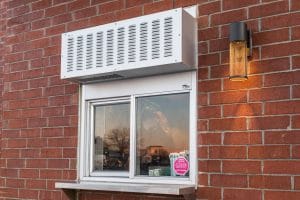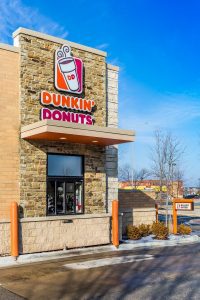The Power of the Drive Thru during COVID-19
As restaurants scramble to change their layout to accommodate social distancing, some have been more successful than others, especially for fast food eat outs. But expensing supplies like disposable containers, masks, gloves, and hand sanitizersSanitizers are chemical agents used to reduce bacteria and m... More have hit all restaurants hard along with lower revenue. Many host stands have also become a thing of the past or were moved outside to allow people more space inside. While these quick transitions feel temporary, it is possible they’re not.
So the big question to ask is, how can restaurants accommodate social distancing and still generate profit?
It may not have been sustainable revenue during the first few months, but making a quick, full transition to online ordering and drive thru and curbside pickup seemed to have worked well for many restaurants. Guests were also able to order quickly and pick up their food at a convenient time, including from sit down restaurants.
Despite some states now allowing restaurants to host indoor seating again, many guests still opt for the pickup option as they simply don’t feel comfortable going in. This new trend can last for months and even years, depending on what happens with the COVID-19 pandemic.
Responding to the Increase in Demand for Restaurant Pick Up
 It is clear restaurants won’t generate much profit when removing and spacing out tables, but they can efficiently and effectively serve guests if they opt for food pickup. In fact, they may even be more successful than they were before the pandemic when the majority of guests preferred on-site dining. Additional revenue can also accommodate the investment in social distancing equipment and supplies like plastic barriers, plastic utensils, wayfinding signs etc.
It is clear restaurants won’t generate much profit when removing and spacing out tables, but they can efficiently and effectively serve guests if they opt for food pickup. In fact, they may even be more successful than they were before the pandemic when the majority of guests preferred on-site dining. Additional revenue can also accommodate the investment in social distancing equipment and supplies like plastic barriers, plastic utensils, wayfinding signs etc.
Long-Term Restaurants Changes
While employees are certainly capable of running food out to waiting cars in the parking lots, large restaurants with over 3,000 square feet of space may want to rethink their investment. As long as the demand for online ordering and curbside pickup remains popular, they may not need all that space.
Transitioning to Quick-Service
Quick service restaurants especially may want to think about testing operations in a smaller facility, downsizing their dining room to two-thirds or even half of their original space. Of course, they should be careful when making the change as it could drastically affect their profit in the future; however, it could be a great way to save money during the pandemic.
Buffalo Wild Wings for example, introduced a new, fast-casual brand called Buffalo Wild Wings Go in Atlanta, GA, operating at an 1,800 square foot restaurant with limited seating. It certainly took time to adjust to a quick-service environment with limited seating, however, they managed to stay afloat under the social distancing guidelines.
Quick-Service Restaurants Today
Despite the reputation of fast food restaurants, they didn’t suffer nearly as much as their sit-down seating competitors. Due to their minimal contact restaurant drive thru windows, they didn’t have to make too many changes. In fact, some fast food restaurants even increased revenue due to their agile response and lack of competition.
Their secret weapon: the drive thru windows. With the ability to order through a machine, cook and send out the food quickly, this method is perfect for social distancing.
How Dunkin’ Donuts is Remodeling Next Generation Stores
 After analyzing the revenues of all stores domestic and overseas, Dunkin’ Donuts planed to close 800 domestic and 350 international stores due to their locations and limited menus. Instead, many are being built in high-traffic locations, some with Next Generation models where they can all have a drive thru window.
After analyzing the revenues of all stores domestic and overseas, Dunkin’ Donuts planed to close 800 domestic and 350 international stores due to their locations and limited menus. Instead, many are being built in high-traffic locations, some with Next Generation models where they can all have a drive thru window.
Scott Murphy, the president of Dunkin’ Americas said this change was part of its brand sticking to its blueprint of using a growth strategy, which included convenience, digital transformation, menu evolution and accessibility. With these changes introduced a new product, Dunkin’ Refreshers, tested with new and existing customers, including a young female demographic. As it appeared to be incremental, many customers continued to buy more drinks and snacks, with an average check just under $7.
Increased Profits with Restaurant Drive Thru Windows
Murphy said these stores are focused on faster, contactless service that was tailor-made for the pandemic. Of all the stores that were remodeled, 90 percent had restaurant drive-thru windows.
Murphy said “the power of the drive-thru is never more evident than during COVID. When we closed dine-in service, our strong base of restaurants with a drive-thru – both NextGen and previous designs – continued to deliver at levels that we’ve never seen before in our system.”
In addition to the success brought on by the drive thru windows, Dunkin’ had also made some adjustments to the design of NextGen to apply learned strategies from COVID. These included the following:
- No-touch bathroom faucets
- Larger pickup areas
- Walk-up windows
- Reconfigured frontline layout to encourage social distancing
- Removable seating
Despite the rise in profits and great success for Dunkin’ Donuts, they have chosen to put dine-in traffic on hold because of the increased COVID cases. There’s certainly enough revenue generated from the drive-thru windows that there is no rush for the brand to reopen seating arrangements.
Increase Revenue with Drive Thru Windows
There is no doubt drive-thru windows are a great asset during the COVID pandemic. But choosing the right drive-thru window for your business is key to making the right investment and growing your business.
With over 40 years of experience in supplying and installing drive-thru windows, Ready Access is proud to be a leader in the industry. Many of the world’s top brands and restaurant chains have known and depended on Ready Access for years as they serve hundreds of customers every day.
Ready Access team is happy to serve business of all industries, including pharmacies, banks, convenience stores, car washes, food trucks, hospital and medical offices, and much more! For more information call (888) 782-0519.












